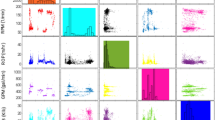Abstract
The circulation of library literature can reflect the utilization of literature, which is of great significance to the prediction. In this study, the Radial Basis Function (RBF) neural network was optimized by Grey Wolf Optimizer (GWO), and the optimization effect of GWO was improved by tent chaotic sequence. The improved GWO-RBF (IGWO-RBF) optimization model was obtained and applied to the prediction of library literature circulation. The experimental results showed that the IGWO-RBF could accurately predict the circulation of literature, with very small prediction error. The RBF prediction curve had the highest fitting degree with the actual curve, followed by the GWO-RBF model and IGWO-RBF model, and both the root-mean-square error (RMSE) and mean absolute percentage error (MAPE) of IGWO were small, indicating good prediction accuracy. This study proves the effectiveness of the RBF optimized model in the prediction of library circulation, and it can be popularized and applied in practice.





Similar content being viewed by others
REFERENCES
Singh, P. and Dwivedi, P., Integration of new evolutionary approach with artificial neural network for solving short term load forecast problem, Appl. Energy, 2018, vol. 217, pp. 537–549.
Chang, G.W., Lu, H.J., Chang, Y.R., and Lee, Y.D., An improved neural network-based approach for short-term wind speed and power forecast, Renewable Energy, 2017, vol. 105, pp. 301–311.
Kasiviswanathan, K.S., He, J., Sudheer, K.P., and Tay, J.H., Potential application of wavelet neural network ensemble to forecast streamflow for flood management, J. Hydrol., 2016, vol. 536, pp. 161–173.
Wang, Z., Wang, B., Liu, C., and Wang, W.S., Improved BP neural network algorithm to wind power forecast, J. Eng., 2017, no. 13, pp. 940–943.
Mozo, A., Ordozgoiti, B., and Gómez-Canaval, S., Forecasting short-term data center network traffic load with convolutional neural networks, PLoS One, 2018, vol. 13, no. 2.
Moghaddam, A.H., Moghaddam, M.H., and Esfandyari, M., Stock market index prediction using artificial neural network, J. Econ. Fin. Adm. Sci., 2016, vol. 21, no. 41, pp. 89–93.
Patra, A., Das, S., Mishra, S.N., and Senapati, M.R., An adaptive local linear optimized radial basis functional neural network model for financial time series prediction, Neural Comput. Appl., 2015, vol. 28, no. 1, pp. 1–10.
Purnomo, H.D., Hartomo, K.D., and Prasetyo, S.Y.J., Artificial neural network for monthly rainfall rate prediction, IOP Conf. Ser.: Mater. Sci. Eng., 2017, vol. 180, no. 1.
Alsina, E.F., Bortolini, M., Gamberi, M., and Regattieri, A., Artificial neural network optimisation for monthly average daily global solar radiation prediction, Energy Convers. Manage., 2016, vol. 120, pp. 320–329.
Yin, J.C., Wang, N.N., and Hu, J.Q., A hybrid real-time tidal prediction mechanism based on harmonic method and variable structure neural network, Eng. Appl. Artif. Intell., 2015, vol. 41, no. 41, pp. 223–231.
Chen, Z., Ding, J., Zhou, H., Cheng, X., and Zhu, X., A model of very short-term photovoltaic power forecasting based on ground-based cloud images and RBF neural network, Proc. CSEE, 2015, vol. 35, no. 3, pp. 561–567.
Satapathy, S.K., Dehuri, S., and Jagadev, A.K., EEG signal classification using PSO trained RBF neural network for epilepsy identification, Inf. Med. Unlocked, 2017, vol. 6, pp. 1–11.
Soleymani, S.A., Goudarzi, S., Anisi, M.H., Hassan, W.H., Idris, M.Y.I., Shahaboddin, S., Noor, N.M., and Ahmedy, I., A novel method to water level prediction using RBF and FFA, Water Resour. Manage., 2016, vol. 30, no. 9, pp. 3265–3283.
Sahoo, A. and Chandra, S., Multi-objective Grey Wolf Optimizer for improved cervix lesion classification, Appl. Soft Comput., 2017, vol. 52, pp. 64–80.
Medjahed, S.A., Saadi, T.A., Benyettou, A., and Ouali, M., Gray Wolf Optimizer for hyperspectral band selection, Appl. Soft Comput., 2016, vol. 40, no. C, pp. 178–186.
Batra, I. and Ghosh, S., An improved tent map-adaptive chaotic particle swarm optimization (ITM-CPSO)-based novel approach toward security constraint optimal congestion management, Iran. J. Sci. Technol. Trans. Electr. Eng., 2018, vol. 42, no. 3, pp. 261–289.
Li, M.L., Practices of the centralized management of new books’ circulation in university libraries: Take library of Guangzhou University as an example, Libr. J., 2014, vol. 33, no. 5, pp. 46–49.
Jia, W., Zhao, D., and Ding, L., An optimized RBF neural network algorithms based on partial least squares and genetic algorithms for classification of small sample, Appl. Soft Comput., 2016, vol. 48, pp. 373–384.
Keshtkarbanaeemoghadam, A., Dehghanbanadaki, A., and Kaboli, M.H., Estimation and optimization of heating energy demand of a mountain shelter by soft computing techniques, Sustainable Cities Soc., 2018, vol. 41, pp. 728–748.
Author information
Authors and Affiliations
Corresponding author
Ethics declarations
The authors declare that there is no conflict of interests.
About this article
Cite this article
Xia Chen, Wanqin Yang Prediction and Analysis of Literature Loan Circulation in University Libraries Based on RBF Neural Network Optimized Model. Aut. Control Comp. Sci. 54, 139–146 (2020). https://doi.org/10.3103/S0146411620020029
Received:
Revised:
Accepted:
Published:
Issue Date:
DOI: https://doi.org/10.3103/S0146411620020029




